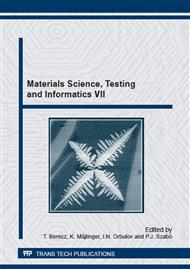p.3
p.9
p.15
p.23
p.29
p.35
p.41
p.47
Prototype of a Human Spinal Disc for Medical Modeling
Abstract:
Medical images were generated in computed tomography devices at the medical partner. The medical image format was transformed into engineering data format by the authors and these data were used for printing the macroscopic model of the spine and the spinal disc and subsequently they were assembled. In addition to this macroscopic prototyping process, a novel microstructure based prototyping process was used for generating structure details of the spinal disc. The fiber reinforced and layered structure of the annulus fibrosus was modeled and in a prototype realized using soft and stiff polymeric materials. This method is based on the material microstructure prototyping methodology developed by the research group of the authors.This basic model could be used for medical education, for patient counselling and to support prosthesis development efforts.
Info:
Periodical:
Pages:
15-21
Citation:
Online since:
February 2015
Authors:
Keywords:
Price:
Сopyright:
© 2015 Trans Tech Publications Ltd. All Rights Reserved
Share:
Citation:


